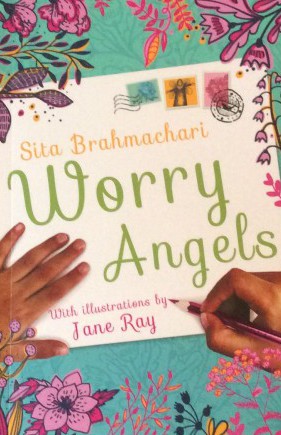Inspiring Young Readers
 posted on 03 Oct 2017
posted on 03 Oct 2017
Worry Angels by Sita Brahmachari, illustrated by Jane Ray
It is a sad fact that many children suffer from anxiety about going to school and they do so for a number of reasons but I think that this story shows that they can still thrive, given the right support. Amy–May has had her share of problems that include her parents separating and a consequent move with her mother to live in a big city. Before this big life change she has lived with both her parents in a seaside cottage somewhere near Whitby, her dad is an artist who makes pottery families but it seems that her mum is thoroughly disillusioned with their bohemian life style. Until now Amy has been home schooled, so has good reason to feel daunted at starting as a pupil at any new school. Fortunately they have moved into a local authority that has Sandcastle Support Centre, a half- way house which provides a nurturing place where Amy can take the necessary time to adapt. Grace Nuala is the wonderfully kind counsellor whose job is to help children and anyone else who needs a temporary oasis in which to build their confidence through gardening, cooking and art activities that take place in an informal somewhat ramshackle family centre. Children who go there are also encouraged to confront and articulate their worries through talking and plenty of imaginative play. When they are ready to leave the centre, Grace gives them an individually crafted papier-mache angel as a memento and a reminder of their ability to overcome their worries in order to get on with their lives: ‘I never paint their wings till you’re ready to fly’.
Amy soon feels comfortable and begins to enjoy spending time with Grace although she naturally still misses her dad and worries about how he might be faring all alone living in a tiny cottage in a place that is even more cut off than their previous home. But she slowly learns to stop fretting and to keep in touch by writing him newsy letters. She comes across as a very sensitive young girl who is struggling with the loss of her dad but she comes to realise that her problems are relatively small when another girl, Rima starts coming to the centre with her mother and two younger brothers, one of whom has a leg injury. They are newly arrived from Syria having escaped from the war and have been living in a refugee camp. Although they speak different languages, Amy gradually understands that she and Rima can become firm friends. She writes enthusiastically to her dad about how they are learning to communicate and this gives us a real insight into her maturity and developing confidence.
The delicately detailed black and white drawings by Jane Ray are used to good effect throughout and emphasise the sensitivity of the subject. It is also a story based on truth because Sita Brahmachari and Jane Ray are the writer and illustrator in residence at the Islington Centre for Refugees and Migrants where they regularly meet children and other family members who have had to cope with some terrible situations. It seems that places like Sandcastle Support Centre really do exist in the real world, thank goodness. Readers might also reflect on why schools aren’t always such welcoming environments and why there isn’t someone like Grace on the staff to provide on-going reassurance and to offer therapeutic gardening , cooking and creative craft activities. She is such a strong character that she is almost too good to be true. When Amy first meets her she appears like a vision of stability:
‘The sun’s in my eyes and all I can see is a glinting pile of silver and white plaits on top of a woman’s head. They look like the ropes of a ship. Sunshine glows around her. She’s wearing a long dress- the same bright blue as the sky’.
Although the two girls leave the centre and are eventually in the same class, it isn’t always easy:
‘ I’m alright first thing in the morning, but then I feel like I’m vanishing into this massive worry-echo that booms along the corridor like a bomb exploding in my head’.
This is a tender story about loss, friendship, hope and resolution which gives an insight into two very different backgrounds and might provide reassurance for those in similar circumstances, as well as helping to develop empathy. As such, it would provoke some very interesting classroom discussion and the publisher Barrington Stoke has developed freely downloadable resources to help with this. As with all their books, it is a triumph of design with good attention to layout so that even the most reluctant reader can find it accessible.
Karen Argent
October 2017